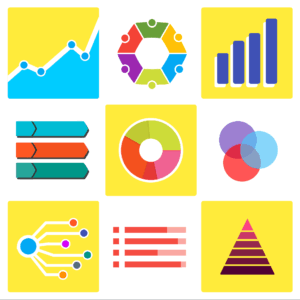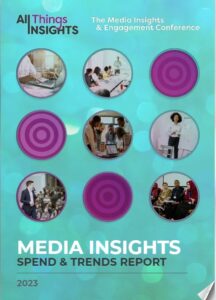A thought leader, consultant, and educator with twenty years of professional experience in the areas of consumer insights and inclusion marketing, Piaggio is focused on finding business growth via inclusion and mobilizing people from all backgrounds to generate positive change. She has consulted with some of the world’s largest organizations on topics of identity, culture, diversity, equity, and inclusion.
Assessing the Inclusivity Climate
All Things Insights: We recently developed several stories on women in the research community, about their leadership and their vision in the discipline. That led us down this path of thinking a little bit more about inclusive research. What do you feel are the most pressing diversity inclusion issues in the market research field today?
Valeria Piaggio: First, we’re seeing many headwinds. But some of the most pressing challenges have to do with the overall environment we’re working in. The industry is experiencing some of the effects of a very complex sociopolitical environment, particularly in the U.S., but in some other countries as well, where efforts to dedicate resources to better understand people of all backgrounds are sometimes discouraged, in others, even penalized.
So this climate creates real barriers for organizations that are striving to expand their market and reach these high growth yet sometimes underrepresented segments in the market. What I’m talking about here is efforts towards expansive marketing, which has to do with understanding who these high growth segments are and with them, growing our market potential.
In addition to this environment, the new technologies we have at hand are wonderful in many ways, but they are also built on legacy data and traditional research paradigms. What I would question is how good these paradigms and traditional research are in terms of bringing to life these voices I’m talking about, these smaller segments, sometimes underrepresented segments.
In some cases, these voices might be diluted. We must remain vigilant in terms of ensuring that these innovations don’t lead to the reinforcement of biases, which sometimes can permeate the process. We must create insights that are a reflection of our society and understand people for who they are.
Bring Diverse Perspectives to Studies
All Things Insights: That’s an excellent foundation for our conversation. Bias has always been an issue in market research, as far as methodologies and frameworks. Is AI bringing this to the forefront a little bit more? There’s the saying about data quality, about what you put in and what you get out of it. Is this a call for market researchers to really strive to prevent or reduce bias in their own work?
Valeria Piaggio: As you pointed out, bias has always been an issue. It permeates every stage of the research process, from how we define the audience we’re studying to the sample, data collection and analysis, and so on.
Now with AI, because it is more obscure how we’re getting to the end result, it is even more important that we have an intention to interrupt bias at each step of our research process, which includes various factors. There are so many ways in which we can tackle bias. The first thing I would say is to ensure that as we approach a new topic, as we approach studying a new population, that we bring diverse perspectives in.
When we’re doing global studies, we need to make an effort to speak to the local experts and localizing questionnaires, ensuring basically that every aspect of the research process is scrutinized with that lens of, are we embedding our humanity in the process? Are we striving to be inclusive of all the different perspectives that need to be taken into account?
Those are some of the strategies to deal with this. An example that I can give you from what we have recently done is a brand inclusion index. This is a project we embarked on for two years, and we finally made a global study. Eighteen countries, more than 20,000 respondents, five regions, eleven languages, and so forth. Instead of approaching it as a copy paste approach, we made a concerted effort to bring in the diverse perspective of experts in these 18 countries. Localizing everything from the languages that we were going to include, the way we needed to ask about people’s identity, the ways in which we needed to position these questions and the options we gave people to self-identify. That has to do with everything. It has to do with gender identity and sexual orientation, neurodiversity, socioeconomic background, all these different dimensions of people’s identity that sometimes we take for granted.
We made a very intentional effort to listen to how people see themselves, avoiding labels, avoiding things that might lead to a very biased perspective of the data. The benefit is clear. It’s, as you said, data quality, ensuring we gather responses that are close to the reality of the market and are close to the real perspectives of consumers.
Weighing Synthetic Data
All Things Insights: We read recently that Kantar won an ESOMAR award for that study. Speaking of the market today with AI technology, what are your thoughts on synthetic data? Some debate that it could help with niche groups and underexposed groups. Do you feel that could help augment research in the future?
Valeria Piaggio: Synthetic data could be used with those positive purposes of enlarging a sample that maybe it’s really hard to find, trying to create digital twins and so forth. But my concern has to do with the quality of the data that goes into generating that sample and how it is being trained. If we don’t have people who know what good real data looks like, the outputs are not going to look anything like real data. That is my main concern. The opportunity is there, and it’s great. It is very exciting to think about what we could do with it. My concern is that from my perspective, we are starting from a very low point.
There are studies like the one I have mentioned where we have made a concerted effort to bring underrepresented voices to life. We went into so much effort in terms of getting to the native populations in some countries. Using an accessible survey to get to people who sometimes can’t access a survey because new surveys are gamified or are only mobile friendly, and then they can’t take the survey.
All of these efforts give you a sense of where is our starting point? My concern is our starting point today is still very low. Unless you first make an effort to generate that real data with the perspective of all these segments that are sometimes excluded from traditional research, what we’re going to get out of it is not of good quality. We might be reinforcing biases instead of augmenting the voices of the underrepresented respondents.
Creating a Diverse Team
All Things Insights: What are your thoughts on how to increase inclusivity in insights and research? What would be your advice in terms of best practices?
Valeria Piaggio: My advice is simple. First, really analyzing who comes in. Who are the practitioners, the professionals who are going to be designing the studies, who are going to be bringing their own perspective to the work, and ensuring that those teams are representative of the market we serve.
Sometimes we forget why we are talking about diversity. It is not just because we want to give someone an opportunity. It is because our society is diversifying and the markets we are trying to reflect are changing. There’s an evolution that needs to be reflected in those who work in these projects. We know it’s proven by data, by research, that diverse teams are more creative, they’re more innovative, and, ultimately, they are more effective because they’re less likely to make serious mistakes. When different perspectives are present and you challenge each other, there are better results.
In terms of leadership, having that intentional perspective when recruiting, when developing, when empowering talent is quite important. This ensures that all voices are valued and are part of the research process.
Intentional Leadership to Understand People
All Things Insights: Is there anything else about inclusive research that you’d like to share with our audience?
Valeria Piaggio: Certainly. I talked a little bit about intentionality. That needs to be something that we reflect on, thinking about why we’re doing the work, what we’re trying to reflect, and thinking about what’s the ultimate purpose, which is better understanding people, better understanding consumers, patients, shoppers. You fill in the blanks but in terms of at the end of the day, we are trying to better understand people. That is critical because as we have that intentionality, that goal in mind, all decisions are then easier to make in terms of how we get there. How do we find the best methodology, the perfect questionnaire, how we also then look at the results and communicate those results in ways that we bring those voices to life.
Contributor
-

Matthew Kramer is the Digital Editor for All Things Insights & All Things Innovation. He has over 20 years of experience working in publishing and media companies, on a variety of business-to-business publications, websites and trade shows.
View all posts
























































































































































































